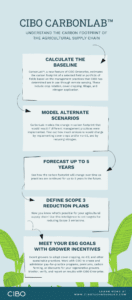
Understanding the carbon footprint of a company’s agricultural supply chain is important in mitigating the impact of greenhouse gas emissions on the environment. Agricultural activities contribute significantly to global greenhouse gas emissions, and companies with agricultural supply chains must increasingly account for on-farm emissions in their Scope 3, ESG, and sustainability programs reporting.
The carbon footprint of a company’s agricultural supply chain refers to the total amount of greenhouse gas emissions released into the atmosphere as a result of the farming practices that go into the production of food, feed, fiber, and fuel feedstocks it sources for its products. The on-farm practices are especially important since those are able to either reduce emissions, avoid emissions, or sequester CO2 and CO2 equivalents in and under the soil.
To understand the carbon footprint of an agricultural supply chain, it is important to consider various factors, including:
- Farming practices like cover cropping, low-till and no-till farming
- Diesel usage
- Nitrogen application (especially in the case of corn)
- Biologicals application and other inputs.
Understanding GHG emissions factors and adopting a proven emissions accounting protocol like GHGP and SBTi is an important first step towards accounting with confidence. Adopting your emissions accounting protocol establishes what you will count and how you will measure your results.
Having a platform with accounting capability built in that works at scale is a vital second step. Adopting your emission accounting platform – like CIBO Impact – enables you to implement your accounting protocol over all your acres and through all the growing seasons required by reporting initiatives.
Companies start by quantifying a baseline of emissions across all the farms, fields and supply sheds from which they source. This baseline becomes the foundation against which all subsequent improvements are measured. Having the ability to quantify emissions and carbon sequestration at individual parcel levels and at massive supply shed levels is an important capability for companies to ensure exists in their technology solution.
After the baseline is established, then modeling different scenarios to better understand the impact of weather, cropping systems, and farming practices on emissions and carbon sequestration is a key step. This allows companies and their trusted advisors to engage growers with insight and data to better deliver confident recommendations and requests that will result in better emissions performance.
Finally, a technology platform that can combine baselining, what-if scenario modeling and incentive programs that make it easy for advisors, and growers to prequalify and enroll their land is the best of all possible worlds. CIBO Impact is just this platform. With CIBO CarbonLab(™) users can compare different practices, crops, weather and management scenarios to identify, target, and deploy programs that accelerate achievement of their carbon, climate, and Scope 3 goals.
By understanding the carbon footprint of their agricultural supply chain, companies can identify areas for improvement and implement strategies to reduce their carbon footprint and Scope 3 emissions. Understanding and reducing their carbon footprint of agriculture supply chains is crucial in the fight against climate change and corporate initiatives to get to a net-zero carbon economy.



